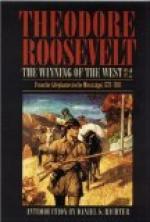Early in the forenoon Clark summoned the fort to surrender, and while waiting for the return of the flag his men took the opportunity of getting breakfast, the first regular meal they had had for six days. Hamilton declined to surrender, but proposed a three days’ truce instead. This proposition Clark instantly rejected, and the firing again began, the backwoodsmen beseeching Clark to let them storm the fort; he refused. While the negotiations were going on a singular incident occurred. A party of Hamilton’s Indians returned from a successful scalping expedition against the frontier, and being ignorant of what had taken place, marched straight into the town. Some of Clark’s backwoodsmen instantly fell on them and killed or captured nine, besides two French partisans who had been out with them. [Footnote: Do. In the letter to Mason he says two scalped, six captured and after-wards tomahawked. Bowman says two killed, three wounded, six captured; and calls the two partisans “prisoners.” Hamilton and Clark say they were French allies of the British, the former saying there were two, the latter mentioning only one. Hamilton says there were fifteen Indians.] One of the latter was the son of a creole lieutenant in Clark’s troops, and after much pleading his father and friends procured the release of himself and his comrade. [Footnote: The incident is noteworthy as showing how the French were divided; throughout the Revolutionary war in the west they furnished troops to help in turn whites and Indians, British and Americans. The Illinois French, however, generally remained faithful to the Republic, and the Detroit French to the crown.] Clark determined to make a signal example of the six captured Indians, both to strike terror into the rest and to show them how powerless the British were to protect them; so he had them led within sight of the fort and there tomahawked and thrown into the river. [Footnote: Hamilton, who bore the most vindictive hatred to Clark, implies that the latter tomahawked the prisoners himself; but Bowman explicitly says that it was done while Clark and Hamilton were meeting at the church. Be it noticed in passing, that both Clark and Hamilton agree that though the Vincennes people favored the Americans, only a very few of them took active part on Clark’s side.] The sight did not encourage the garrison. The English troops remained firm and eager for the fight, though they had suffered the chief loss; but the Detroit volunteers showed evident signs of panic.
Surrender of the Fort.
In the afternoon Hamilton sent out another flag, and he and Clark met in the old French church to arrange for the capitulation. Helm, who was still a prisoner on parole, and was told by Clark that he was to remain such until recaptured, was present; so were the British Major Hay and the American Captain Bowman. There was some bickering and recrimination between the leaders, Clark reproaching Hamilton with having




